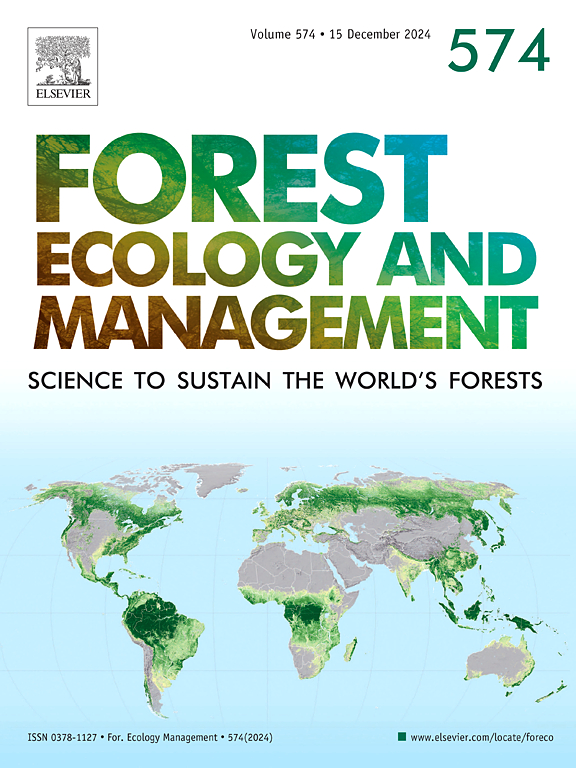Tree growth response to the 2022 compound drought and heatwave on the eastern Qinghai-Tibetan Plateau
IF 3.7
2区 农林科学
Q1 FORESTRY
引用次数: 0
Abstract
With global climate warming, compound extreme climate events, combining droughts and heatwaves are increasing in frequency and intensity. In 2022, the eastern Qinghai-Tibetan Plateau experienced a once-in-a-century compound drought and heatwave, which probably had a profound impact on tree growth. To assess the extent of this impact, we investigated Minjiang fir (Abies fargesii var. faxoniana) at different growth stages (seedling, sapling, and mature tree) and elevations (low, middle, and high). We found that there was no significant change in the diameter class structure of the Minjiang fir population after the 2022 heatwave–drought, although the mortality rate increased insignificantly. The event significantly promoted the height growth of seedlings and saplings and the radial growth of mature trees at low elevations in 2022. It significantly suppressed the growth of branches in seedlings and saplings across all elevations. There was a unimodal effect on tree growth of the event that varied with elevation, and the sensitivity of tree growth to the event declined from seedlings to mature stages. This study enhances our understanding of the response dyssynchrony of tree growth to unstable states in the subalpine region. This study is helpful in planning the protection and utilization of forest resources in the climate-sensitive area of the Qinghai-Tibetan Plateau, which is exposed to increasingly frequent extreme events.
青藏高原东部树木生长对2022年旱热复合的响应
随着全球气候变暖,干旱和热浪等复合极端气候事件的频率和强度都在增加。2022年,青藏高原东部经历了百年一遇的复合干旱和热浪,这可能对树木的生长产生了深远的影响。为了评估这种影响的程度,我们调查了岷江冷杉(Abies fargesii var. faxoniana)不同生长阶段(幼苗、幼树和成熟树)和海拔(低、中、高)。研究发现,2022年热浪干旱后,岷江冷杉种群的径级结构没有显著变化,但死亡率增加不显著。该事件显著促进了2022年低海拔地区幼苗和幼树的高度生长和成熟树木的径向生长。在各海拔高度均能显著抑制幼苗和幼树枝条的生长。事件对树木生长的影响呈单峰效应,随海拔高度的变化而变化,树木生长对事件的敏感性从幼苗期到成熟期逐渐下降。本研究提高了我们对亚高山地区树木生长对不稳定状态的非同步性响应的认识。研究结果对青藏高原气候敏感区森林资源的保护与利用规划具有重要意义。青藏高原气候敏感区极端事件频发。
本文章由计算机程序翻译,如有差异,请以英文原文为准。
求助全文
约1分钟内获得全文
求助全文
来源期刊

Forest Ecology and Management
农林科学-林学
CiteScore
7.50
自引率
10.80%
发文量
665
审稿时长
39 days
期刊介绍:
Forest Ecology and Management publishes scientific articles linking forest ecology with forest management, focusing on the application of biological, ecological and social knowledge to the management and conservation of plantations and natural forests. The scope of the journal includes all forest ecosystems of the world.
A peer-review process ensures the quality and international interest of the manuscripts accepted for publication. The journal encourages communication between scientists in disparate fields who share a common interest in ecology and forest management, bridging the gap between research workers and forest managers.
We encourage submission of papers that will have the strongest interest and value to the Journal''s international readership. Some key features of papers with strong interest include:
1. Clear connections between the ecology and management of forests;
2. Novel ideas or approaches to important challenges in forest ecology and management;
3. Studies that address a population of interest beyond the scale of single research sites, Three key points in the design of forest experiments, Forest Ecology and Management 255 (2008) 2022-2023);
4. Review Articles on timely, important topics. Authors are welcome to contact one of the editors to discuss the suitability of a potential review manuscript.
The Journal encourages proposals for special issues examining important areas of forest ecology and management. Potential guest editors should contact any of the Editors to begin discussions about topics, potential papers, and other details.
 求助内容:
求助内容: 应助结果提醒方式:
应助结果提醒方式:


